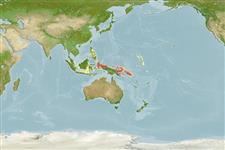>
Ovalentaria/misc (Various families in series Ovalentaria) >
Pseudochromidae (Dottybacks) > Pseudochrominae
Etymology: Pholidochromis: Name from Greek pholis, meaning a scale or spot, chromis a genus of pomacentrid that has been used as the stem of various other fish genera, alludes to the distinctive dark spots around the head pores.; marginatus: Name from Latin meaning to furnish with a border, refers to the typical dark submarginal stripes on the caudal, dorsal and anal fins (Ref. 81967).
Issue
Gender agreement to be confirmed. Is kept marginatus as in the original name in Eschmeyer (CofF ver. Jul. 2010: Ref. 84883).
Environment: milieu / climate zone / depth range / distribution range
Ecologia
marino associati a barriera corallina; distribuzione batimetrica 1 - 10 m (Ref. 81967). Tropical
Western Central Pacific: Papua New Guinea, Solomon Islands and Indonesia..
Size / Peso / Age
Maturity: Lm ? range ? - ? cm
Max length : 4.9 cm SL maschio/sesso non determinato; (Ref. 26137)
Short description
Morfologia | Morfometria
Spine dorsali (totale): 3; Raggi dorsali molli (totale): 22; Spine anali 3; Raggi anali molli: 13.
Found in shallow water in areas of living hard and soft corals (Ref. 26137); sometimes in relatively silty areas (Ref. 81967).
Life cycle and mating behavior
Maturità | Riproduzione | Deposizione | Uova | Fecundity | Larve
Kailola, P.J., 1987. The fishes of Papua New Guinea: a revised and annotated checklist. Vol. II Scorpaenidae to Callionymidae. Research Bulletin No. 41, Research Section, Dept. of Fisheries and Marine Resources, Papua New Guinea. (Ref. 6192)
IUCN Red List Status (Ref. 130435)
Threat to humans
Harmless
Human uses
Informazioni ulteriori
Nomi ComuniSinonimiMetabolismoPredatoriEcotossicologiaRiproduzioneMaturitàDeposizioneSpawning aggregationFecundityUovaEgg development
Age/SizeAccrescimentoLength-weightLength-lengthLength-frequenciesMorfometriaMorfologiaLarveDinamica popolazioni larvaliReclutamentoAbbondanzaBRUVS
BibliografiaAcquacolturaProfilo di acquacolturaVarietàGeneticaElectrophoresesEreditarietàMalattieElaborazioneNutrientsMass conversion
CollaboratoriImmaginiStamps, Coins Misc.SuoniCiguateraVelocitàModalità di nuotoArea branchialeOtolithsCervelliVista
Strumenti
Special reports
Download XML
Fonti Internet
Estimates based on models
Preferred temperature (Ref.
123201): 28.7 - 29.3, mean 29 °C (based on 238 cells).
Phylogenetic diversity index (Ref.
82804): PD
50 = 0.7500 [Uniqueness, from 0.5 = low to 2.0 = high].
Bayesian length-weight: a=0.00490 (0.00187 - 0.01281), b=3.11 (2.88 - 3.34), in cm total length, based on LWR estimates for this (Sub)family-body shape (Ref.
93245).
Trophic level (Ref.
69278): 3.4 ±0.5 se; based on size and trophs of closest relatives
Fishing Vulnerability (Ref.
59153): Low vulnerability (10 of 100).
